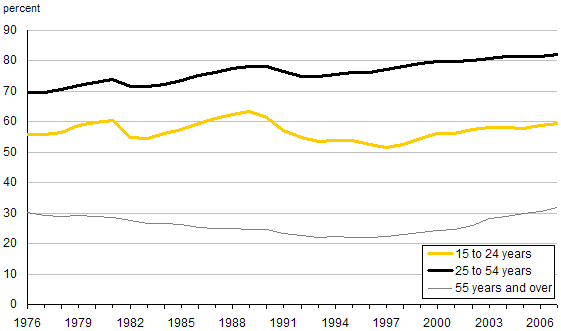Publications
The Canadian Labour Market at a Glance
Employment rates, by age
Archived Content
Information identified as archived is provided for reference, research or recordkeeping purposes. It is not subject to the Government of Canada Web Standards and has not been altered or updated since it was archived. Please "contact us" to request a format other than those available.
Employment rates for older workers are on the rise
- As a result of early retirement trends, the employment rates of people aged 55 and over were on a downward course, hitting a low of 22.0% in 1995. The trend has reversed, however, and in 2007, 31.7% of the population aged 55 and over were employed, the highest rate in more than three decades. This peak is largely due to the influx of baby boomers into this group of older workers.
- Of those who were employed in 2007, 69.9% of workers were adults aged 25 to 54, 15.4% were youth aged 15 to 24, and 14.8% were older workers aged 55 and over. Three decades ago, when the baby boomers were teenagers and young adults, youth held a greater share of all employment. In 1976, more than a quarter of all workers were youth and nearly two-thirds of all workers were adults aged 25 to 54.
-
The employment rate for men is generally higher than for women. However, young women aged 15 to 24 have completely eliminated the employment rate gap between themselves and young men and, in fact, are more likely to be employed. In 2005, the proportion of young women who were employed averaged 59.8% versus 59.1% for young men.
Chart B.4
Employment rates, by age, 1976 to 2007

Source: Statistics Canada, Labour Force Survey, CANSIM table 282-0002.
- Date modified:
